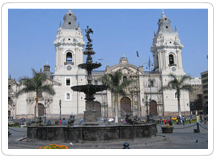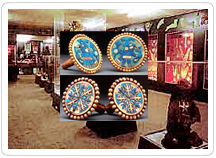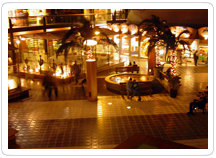
This comprehensive guide delves into the top attractions and highlights of Lima, providing detailed insights to help you choose which of the many wonders of this captivating city to visit.
Founded by Francisco Pizarro in 1535, Lima offers a wealth of experiences for history enthusiasts, culture aficionados, and travelers seeking to explore the vibrant heart of Peru.
The Plaza Mayor, the site of Lima’s founding by Francisco Pizarro, has witnessed some of the most important historic events in Peru. Small shops and businesses originally surrounded the Plaza Mayor. More than a century later, a bronze fountain was built in the center in 1651, and it still stands today. It was in this plaza that Peruvians declared their independence in 1821. The Presidential Palace sits on the northern side of the square, while the Cathedral and Archbishop’s Palace are on the east side, and the City Hall is located to the west.

Built in 1625 in Baroque Renaissance style and rebuilt after an earthquake in 1940, Lima Cathedral is a veritable work of colonial art. While its facade is somewhat austere, the Cathedral houses magnificent Churriguerra altars, beautifully carved wooden choir stalls, and gold-leaf altars. Additionally, it boasts a unique collection of oil paintings and sculptures from the seventeenth and eighteenth centuries.
The Iglesia de San Francisco is a striking complex consisting of a church, the convent of San Francisco, and the chapels of El Milagro and La Soledad. Built in the seventeenth century, the complex’s cloisters and patios are decorated with blue Sevillian tiles. There is also a well-stocked library, the Religious Art Museum, and the Zurbarán Room. The church is built on top of a network of underground tunnels, or catacombs, which were used as a cemetery during colonial times, and today are open to the general public.

Miraflores is Lima’s foremost tourist and hotel district. It features spacious modern shopping areas, parks, and gardens. The district also hosts many cultural events at theaters, cinemas, and art galleries. It boasts a pre-Inca mud-brick temple called the Huaca Pucllana, one of many archaeological sites still found in Lima. Miraflores teems with cozy cafes, pubs, restaurants, and shops. Its freshly remodeled parks and gardens attract thousands of Lima inhabitants every Sunday who congregate to visit art exhibitions, take in open-air concerts, and browse through flea markets.
San Isidro is Lima’s “garden” district, standing out for its green zones and exclusive residential areas. San Isidro also features many of the city’s finest restaurants, hotels, and concert halls. Despite the building boom, San Isidro has retained its aristocratic atmosphere from the beginning of the last century. This is clearly seen in the area of El Olivar, a centuries-old olive grove that evolved into a popular park built around ornate upscale homes. In recent years, the district has become a major financial quarter as many banks and businesses moved from downtown Lima to set up headquarters in modern high-rise office buildings. The district features a pre-Hispanic temple, Huallamarca, where concerts and exhibitions are occasionally held.
Located 19 miles (30 km) south of Lima along the Pan-American Highway, Pachacamac is an ancient temple rearing over the fertile Lurín valley. A sprawling ceremonial center of 18 mud-brick pyramids with ramps and plazas, Pachacamac was ruled by the Ychsma lords from 900 A.D. to 1470. The Inca Empire conquered the religious center less than a century before Spanish Conquistador Francisco Pizarro’s brother, Hernando, plundered the site in 1533 and destroyed the idol that served as an oracle. The Inca section (1440-1533) is the best-preserved part of the archaeological complex. The site includes palaces, plazas, and temples that have been painstakingly restored, and even includes an on-site museum that houses an interesting collection of pre-Hispanic relics. Archaeologists began exploring Pachacamac in the 1890s but found much of the nearly 1,500-acre (600 ha) ruins already looted, and quickly ran out of intact tombs to explore. But not all of Pachacamac’s historical treasures had been sacked. In 2005, archaeologist Peter Eeckhout of the Free University of Brussels excavated 69 tombs and funerary bundles, including some containing whole families. Others held the mummified remains of pilgrims who presumably sought cures from the oracle deity for diseases like syphilis, tuberculosis, and cancer.
The Museo de Oro del Perú is actually two museums rolled into one. Its massive Gold Museum will blow you away with thousands of gold pieces, each uniquely sculptured into something different, from earplugs to clothing decorations. The Arms Museum at the top of the building is one of the world’s best, with thousands of ancient firearms from all over the world. It is astonishing that some of these clumsy-looking old guns were once quite effective.
The Museo Nacional de Antropología y Arqueología houses Peru’s most extensive collection of pre-Columbian artifacts, including 8,000-year-old tools, granite obelisks of the Chavín culture, and weavings of Paracas. Ceramics reflect civilizations such as the Moche, Chimu, and Inca.
The Museo Rafael Larco Herrera started as a repository for Chiclin pottery brought to Lima from Trujillo and today offers some of the finest examples of artifacts from the Mochica period (A.D. 400-800). Also represented are the Cupisnique period (back to 1000 B.C.), and the Nasca, Chimu, and Inca periods. A collection of pre-Columbian weaving includes a sample of two-ply yarns with 398 threads to the inch. However, the museum is most famous for its extensive collection of “huacos eróticos,” explicit ceramic depictions of sexual acts crafted more than 1,500 years ago by the Moche, a highly organized, class-based society that dominated Peru’s northern coast for 800 years.
Lima’s districts of Miraflores and San Isidro offer a contemporary contrast to the historical heart of the city.

Miraflores is renowned for its vibrant cultural scene, modern infrastructure, and numerous recreational facilities. The district is home to some of Lima’s best restaurants, shopping centers, and parks. The Huaca Pucllana, a pre-Inca mud-brick temple, stands as a testament to the district’s ancient past amidst its modern surroundings. Visitors can enjoy leisurely strolls through Parque Kennedy, explore the many art galleries, or indulge in the culinary delights at the myriad of cafes and restaurants. The district’s coastal parks, such as Parque del Amor, offer stunning views of the Pacific Ocean and are popular spots for paragliding and other outdoor activities.
San Isidro is a blend of upscale residential areas, green spaces, and a bustling business district. El Olivar Park, with its ancient olive trees, offers a serene escape from the city’s hustle and bustle. The district is also home to Huallamarca, a pre-Hispanic temple that occasionally hosts cultural events and exhibitions. San Isidro’s reputation for fine dining and luxury accommodations makes it a prime location for both leisure and business travelers. Despite the modern developments, the district has retained much of its historic charm, making it a unique blend of old and new.
North of Lima lies the arid Supe Valley, home to the Caral archaeological complex. This city, dating back 5,000 years, is considered one of the oldest in the Americas and a peer to great civilizations such as Egypt, China, and Mesopotamia. Caral’s architectural complexity, with its pyramids and musical instruments unearthed by archaeologists, speaks of a highly developed society.
A lovely, sunny valley south of Lima, Lunahuaná is a perfect spot for adventure sports and culinary delights. The area is known for its river shrimp dishes, exquisite wines, and pisco spirits. Nearby, the ruins of the ancient Inca Wasi (House of the Inca) archaeological site offer a glimpse into the region’s historical significance.
Encompassing the upper Cañete River Valley, this reserve is a paradise for nature lovers. The area is filled with waterfalls, enchanting lagoons, and abundant wildlife. Visitors can also explore the small villages of Huancaya and Vilca, known for their colonial-era bridges.
Celebrated on January 18th, this event commemorates the founding of the Spanish city of Lima with live music, parades, and popular art fairs.
Held in the second week of March, this festival allows visitors to taste wine and pisco brandy and participate in their preparation at various wineries in the district of Santiago de Surco.
On the first Saturday of February, Peru’s iconic cocktail takes center stage at bars and restaurants throughout Lima.
From April 20th to 28th, the best Peruvian Paso horse breeders gather at the Mamacona Hacienda in Lurín for this prestigious event.
Held during the last two weeks of July, this fair brings together Peruvian and international writers, offering a space crammed with books and literary activities.
In August, this international film festival showcases Latin-American films, allowing visitors to watch, vote, and meet filmmakers from around the world.
In October, the image of the Lord of Miracles is carried in massive processions through the streets of downtown Lima. It is the most attended religious procession in Peru and one of the most significant in the world.
Celebrated on October 31st, this day honors Peru’s traditional coastal music with concerts in bars, restaurants, and plazas throughout Lima.
Lima is a city that seamlessly blends historical significance, cultural richness, and modern vibrancy. From exploring its colonial architecture and world-class museums to enjoying its bustling districts and serene parks, visitors will find a wealth of experiences to enrich their journey. Join us in discovering the highlights and rich heritage of Lima, a destination that promises to captivate and inspire.